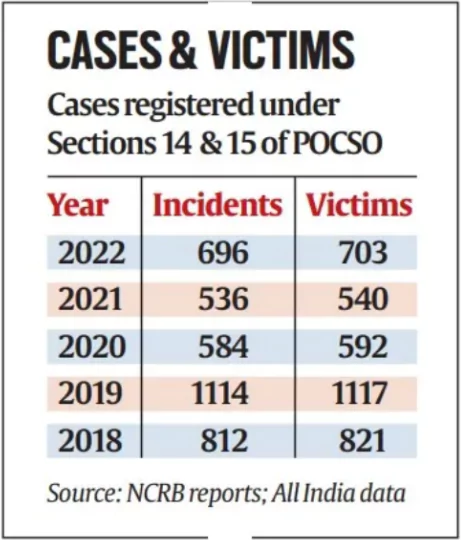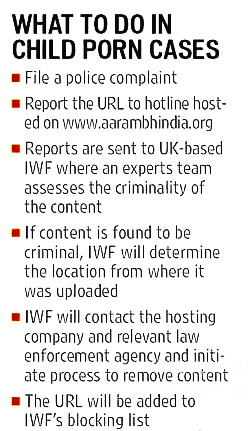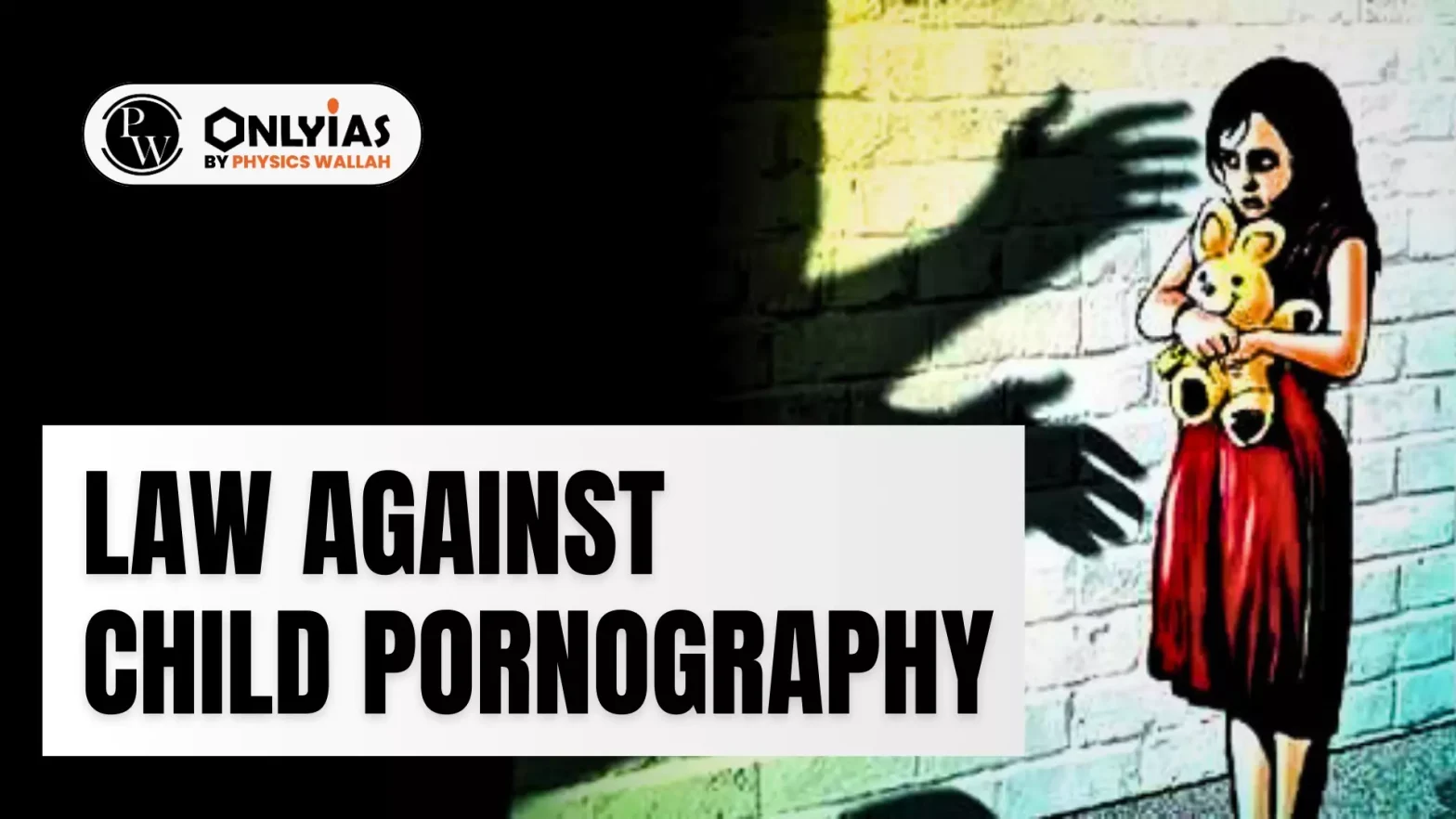The Supreme Court in its recent order has tightened the law on Child Pornography outlining a strict interpretation as to what constitutes an offense of “storage of child pornography”.
Background
- Petitioner: The decision comes in a plea filed by Just Rights for Children Alliance.
Section 15 of POCSO Act- “Punishment for storage of pornographic material involving a child”:
- The POCSO Act was amended in 2019 to introduce three connected offences under Sections 15,with increasing grades of punishment.
- Sections 15(1): Storing/ possessing child pornographic material, but failing to delete or destroy or report it to the designated authority with an intention to share or transmit it shall be liable to a fine not less than five thousand rupees.
- Sections 15(2): Storing/ possessing child pornographic material for transmitting or propagating or displaying or distributing in any manner except for the purpose of reporting or for use as evidence in court shall be punished with imprisonment extending upto three years, or with fine, or both.
- Section 15(3): Any person, who stores or possesses pornographic material in any form involving a child for commercial purpose shall be punished with imprisonment not less than three years which may extend to five years.
|
- Background: The Supreme Court has overruled the single-judge Bench order of the Madras High Court quashing criminal proceedings against a 28-year-old man charged with downloading and possessing child pornography on his mobile phone.
- Charges: The accused was charged with violating Section 14(1), which punishes using children for pornographic purposes and Section 67B of the Information Technology Act 2000.
- Ground of Acquittal: There was no evidence of the accused using a child for pornographic purposes or transmitting, sharing or publishing the material he possessed.
Enroll now for UPSC Online Course
About the Supreme Court Judgement
- The Court expanded on the interpretation of Section 15 of the POCSO Act, dealing with the “Punishment for storage of pornographic material involving a child”.
- “Inchoate” Offense: Even Possession of child pornographic material without ever transmitting or sharing it will also be considered an ‘overt steps’ taken towards committing a crime ie. Section 15 could even be used to punish the “intent” to commit such an act.
- Inchoate offenses are the acts that are in anticipation or preparation for committing a further criminal act.
- Defined “Possession”: Possession in child pornography cases goes beyond just physical possession and includes “constructive possession” ie. the power to control the material in question and the knowledge of exercise of such control.
- It held that viewing, distributing or displaying such material irrespective of whether it is shared or transmitted would still amount to it being in the accused’s “possession” under Section 15.
- Example: The Power and Knowledge of control includes streaming the images on internet without even downloading or the ability to print them, save them, forward them or delete them etc.
- Emphasis on Reporting: A person will only be absolved of any liability of possessing Child Pornographic content only when he/she reports it to the specified authorities.
- Penalty: There is a provision for penalty for not reporting a case with a fine not less than five thousand rupees in the first instance.
- Fixing Liability: A person can be convicted of an offense if it is established that he possessed the child pornographic material “at any given point” and not necessarily at the time of filing of an FIR.
- It means that if a person immediately after storing and watching child pornography deletes the same before an FIR could be registered could still be found liable under Section 15.
- Determining “Intention”: The intention or mens rea of the accused can be determined based on the ‘manner’ in which such material is stored or possessed and the ‘circumstances’ in which the same was not deleted, destroyed or reported.
- A failure to delete or destroy or report child pornography would allow the court to “indirectly” infer that the concerned individual intended to share or distribute it under Section 15(1).
- Registering of Case: The court guided the police and lower courts into making an enquiry with respect to all the sub-sections under Section 15 while making out a case.
- The sub-sections (1), (2) and (3) of Section 15 are independent of each other. If a case is not falling within one sub-section, that does not mean that it does not fall within the entire Section 15.
- Change in Terminology: The Court has asked the Parliament to amend the term child pornography with the term ‘child sexual exploitative and abusive material‘ by bringing an Ordinance.
- Social Media Platform Responsibilities: Social Media Intermediaries cannot claim exemption from the liability under Section 79 of the IT Act in cases of Child Pornography and has to follow due diligence by removing such content and also making an immediate report of such content to the concerned police units in the manner specified under the POCSO Act.
About Child Pornography
- Child Pornography is “any visual depiction of sexually explicit conduct involving a minor” ie. below 18 years of age. These depictions can be across a number of different media, including:
 Photographs; Videos; Digital images or videos; Undeveloped film; Computer generated images indistinguishable from an actual minor
Photographs; Videos; Digital images or videos; Undeveloped film; Computer generated images indistinguishable from an actual minor
- Child Porn Market: As per the US-based National Centre for Missing and Exploited Children (NCMEC),
- India accounts for the maximum number of online child sexual abuse imagery in the world with Indian users having uploaded 25,000 images or videos in the first half of 2024
- Delhi tops the list for the maximum uploads of child porn, followed by Maharashtra, Gujarat, Uttar Pradesh and West Bengal.
- NCRB Data: As per the latest NCRB report 2018, India reported 781 cases of creating or storing child porn with Odisha reporting the maximum number of such cases (333).
- NCRB estimates that one child is sexually abused every 15 minutes in India.
Legal Provisions Relating to Child Pornography
- Section 67B of The IT Act, 2000: It specifically provides stringent punishment for publishing, browsing or transmitting child pornography in electronic form.
- Section 79 of the IT Act and The Information Technology (Intermediary Guidelines) Rules 2011: It requires the Social Media intermediaries observing due diligence to inform the authorities about the user.
- Section 14 of the POCSO Act, 2012: It punishes the use of a child or children for pornographic purposes with imprisonment extending to five years
- Section 15 of POCSO: It punishes the act of storing for commercial purposes any pornographic material in any form involving a child punished with imprisonment extending to three years.
- Section 107 of Juvenile Justice Act: POCSO Rules 2020 gives the jurisdiction to the Special Juvenile Police Unit (Section 107 of JJ) to deal with child pornography matters.
- Clause 95 of the Bhartiya Nyay Sanhita: The clause punishes a person who hires, employs or engages any person below the age of 18 years to commit an offence. Using a child for sexual exploitation or pornography is included within its meaning.
|
Impact of Pornography on Children And Society
- Psychological Impact: Children exposed to porn may usually be subject to depression, anger, and anxiety causing mental anguish.
- Sexual Addiction: Watching porn produces a sense of sexual gratification and obsession which can take the form of addiction which can affect the daily functioning of children, their biological clock, work, and their relationship with society.
- Sexual Objectification: Adolescent pornography perpetuates gender stereotypes, especially on males who are more likely to look at women as sex material which might encourage attitudes sympathetic to sexual abuse and violence against women.
- Engage in Unsafe Sex: Children exposed to porn may try unsafe sexual health practices like not using condoms and unsafe anal and virginal sex.
Check Out UPSC CSE Books From PW Store
Challenges
- Lax Attitude: Social Media Intermediaries are not acting fast enough in the removal of such content focusing instead on revenue and maximum visibility in countries with relatively less stringent laws.
- Example: In USA, these intermediary companies record and report child porn instances to a governing body and also make it public.
- Expansive Network: Child Porn can be created by literally anyone from a family member to a criminal racket or cyber stranger or even self-generated. The Network consist of creators, distributors, consumers all distinct from one another, therefore difficult to trace.
- Cyber Grooming: Children are being groomed to participate in sexual activities through social media friends, peers or trafficking rackets operating online through coercion, blackmail or simply persuasion.
- As per reports, 70-90 per cent of all child abuse is perpetrated by people known to the child.
- Creating a Cycle of Abuse: Child sex abuse is mainly a result of more intimate experiences a child face in its environment like pathological family atmosphere with exposures to sexual behaviours and sexual acts, molestation in childhood, sexual interests and exploration, coercion into homosexual acts, which increases the risk of them becoming young sexual offenders
- Easy Availability on Dark Web: Transactions in cryptocurrency, onion routing, encrypted chats and Protonmail (which also cannot be tracked) makes investigating Dark Web extremely time consuming and tedious process requiring only a specialised agency.
- Example: Search engines like Onion Land and Onion Dir host videos of child torture, images of children with aggressive animals and of children taking nude selfies etc.
Way Forward
Recommendations of The ‘Ad Hoc Committee of the Rajya Sabha (2020) on Pornography and its Effect On Children And Society:
- Enlarge the scope of POCSO: Cyber grooming, advocating or counselling sexual activities with a person under 18 should be made an offence under the Protection of Children from Sexual Offences (POCSO) Act.
 Take Down of Child Sexual Abuse Material (CSAM) from Internet: Modify the IT (Intermediary Guidelines) Rules 2011, to make Intermediaries responsible to pro-actively identify and remove Child Sexual Abuse Material (CSAM) as well as report it to Indian authorities under the National Cybercrime Portal.
Take Down of Child Sexual Abuse Material (CSAM) from Internet: Modify the IT (Intermediary Guidelines) Rules 2011, to make Intermediaries responsible to pro-actively identify and remove Child Sexual Abuse Material (CSAM) as well as report it to Indian authorities under the National Cybercrime Portal. - Monitor Children’s Access to Pornographic Content: The MeitY should mandate existing screen-monitoring apps or encourage industry partnerships to develop it like the Google’s Family Link App and made freely available to ISPs, companies, schools and parents.
- A nodal Agency for Child Pornography: National Commission for Protection of Child Rights (NCPCR) should be designated as the nodal agency to deal with the issue of child pornography with added responsibilities of investigation, cyber policing and prosecution.
- International Cooperation: India should sign mutual agreements with other countries for sharing information in dark web investigations and fast-track requests for the take down of online content under the Mutual Legal Assistance Treaty.
- Education and Awareness: Digital Safety Education should be included in school curriculum and also through workshops for the parents etc. Children should be made more aware of their bodies and rights via sex education
- Monitor Dark Web: A cyber-crime investigative agency needs to be set up in India, especially to monitor the dark web, as it is where a significant chunk of porn is being viewed.
- Example: On specialised encrypted search engines like Onion Land, a search for ‘child porn’ throws up over 130 website links, and a search for ‘child porn India’ around 50.
Enroll now for UPSC Online Classes
![]() 24 Sep 2024
24 Sep 2024

 Photographs; Videos; Digital images or videos; Undeveloped film; Computer generated images indistinguishable from an actual minor
Photographs; Videos; Digital images or videos; Undeveloped film; Computer generated images indistinguishable from an actual minor Take Down of Child Sexual Abuse Material (CSAM) from Internet: Modify the IT (Intermediary Guidelines) Rules 2011, to make Intermediaries responsible to pro-actively identify and remove Child Sexual Abuse Material (CSAM) as well as report it to Indian authorities under the National Cybercrime Portal.
Take Down of Child Sexual Abuse Material (CSAM) from Internet: Modify the IT (Intermediary Guidelines) Rules 2011, to make Intermediaries responsible to pro-actively identify and remove Child Sexual Abuse Material (CSAM) as well as report it to Indian authorities under the National Cybercrime Portal. 